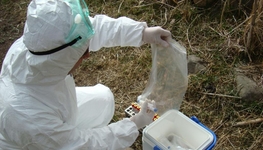01/02/2011
Taking Care of Cattle Health - Brucellosis Control in Armenia
 A small herd of cows blocked the picturesque mountain road as our vehicle approached the beautiful town of Goris in the south of Armenia. Cows appeared to be healthy and robust, yet something was different about them. We realized that it was the fact that their ears were tagged, a sign that these cattle had been vaccinated against brucellosis, as we were told by Armen Sedrakyan, manager of the project Assistance to Brucellosis Control in Armenia, within the Food and Agriculture Organization (FAO) of the United Nations.
A small herd of cows blocked the picturesque mountain road as our vehicle approached the beautiful town of Goris in the south of Armenia. Cows appeared to be healthy and robust, yet something was different about them. We realized that it was the fact that their ears were tagged, a sign that these cattle had been vaccinated against brucellosis, as we were told by Armen Sedrakyan, manager of the project Assistance to Brucellosis Control in Armenia, within the Food and Agriculture Organization (FAO) of the United Nations.
Brucellosis is dangerous not only for cattle, sheep and goat and other animals but is also a threat to humans. The disease can spread through non-pasteurized dairy products and direct contact with infected animals. Brucellosis in small ruminants and cattle has been on the increase in Armenia since the late 1990s despite government programmes implemented through the Ministry of Agriculture and the Ministry of Health.

In May 2007 the FAO office in Armenia supported an initiative of the Armenian government with the objective of developing sustainable mechanisms aimed controlling the brucellosis disease, which complements the Poverty Reduction Strategy Policy of Armenia. The initiative is funded by the Italian Government.
The overall goal now is to analyze the epidemiology of brucellosis in order to design and implement proper cost-effective control strategies. Several parallel technical methods for control of the disease had been tested in pilot studies and effectively implemented in the Syunik region. Crucial for the project’s success is the close cooperation and coordination among all partners, jointly led by the Ministries of Agriculture and Health.
Liana Torosyan from the Ministry of Health explained: “Presently, experts are working on a National Strategy, which includes lessons learned from this pilot project. Upon its adoption, we hope to jointly agree on a National Action Plan for brucellosis control.”
However, ordinary villagers are already benefiting from the project. Many of them are testing the blood of their animals and taking an active role in stopping the spread of zoonoses in their households, thanks to the everyday efforts of veterinarians who travel from village to village, explaining both the dangers of brucellosis and prevention measures.

Gavrusha Grigoryan, a veterinarian from the village of Khndzoresk, who has attended training sessions conducted in the framework of the project, shared his concerns. He said that it is hard to convince owners, who often depend on the income from the sale of their herd or milk, to support their families, to slaughter cattle and test regularly the blood of remaining healthy animals. 10-15 healthy cows give 100 liters of milk per day, while sick animals have a drastically reduced yield of milk. However, the veterinarian proudly shared that the recently conducted public awareness campaign was successful in that many peasants gained a better understanding of the dangers of keeping sick animals and were more eager to listen to the advice they received from the doctors.
“We work in a mountainous area where the roads are bad and often blocked either by snow or landslides. It is hard to monitor the situation and to be aware of all of the day-to-day concerns of my clients. We really need to have a veterinarian in each community. That will not only preserve our limited funds but will make us more efficient. We also need more modern equipment, and we are eager to learn new methods of tackling this disease.”
“Our main objective is to encourage self-support in local communities through improved livestock production and reduction of brucellosis infection in livestock and humans, and to prevent a loss of income from brucellosis in livestock and to strengthen the Government’s capacity to respond to animal and human health concerns,” continued Grisha Baghiyan, Head of Food Safety and Veterinary State Inspectorate of Armenia.
Eduard Tokhsants, Head of the Food Safety and Veterinary Inspection of Syunik region, and his colleagues from the local branch of the Ministry of Health are working hand-in-hand on the implementation of the project and coordinating their efforts on the local level while the national authorities cooperate in Yerevan.
Numerous training sessions were organized to challenge public and animal health authorities to improve their epidemiology surveillance and organize preventions campaigns.
“Specific attention is paid to public awareness and the educational campaign aimed at reducing the risk of transmission from animals to humans by encouraging safe practices such as the scalding of milk before consumption, reporting abortions so that infected animals can be isolated and infected premises can be disinfected and the participation of villagers in management of the control programme,” shared Lena Malitsyan from the regional health office.
Authorities now believe that it is possible to achieve a measurable reduction in brucellosis prevalence in small ruminants. Merely the fact that this is now a realistic goal is a major accomplishment and is due to the effective cooperation between the Ministries of Agriculture and Health, summarizes Gayane Nasoyan, Assistant FAO Representative in Armenia.
Submitted by: Maria Dotsenko
Project: UNDPI/Armenia, 2011
